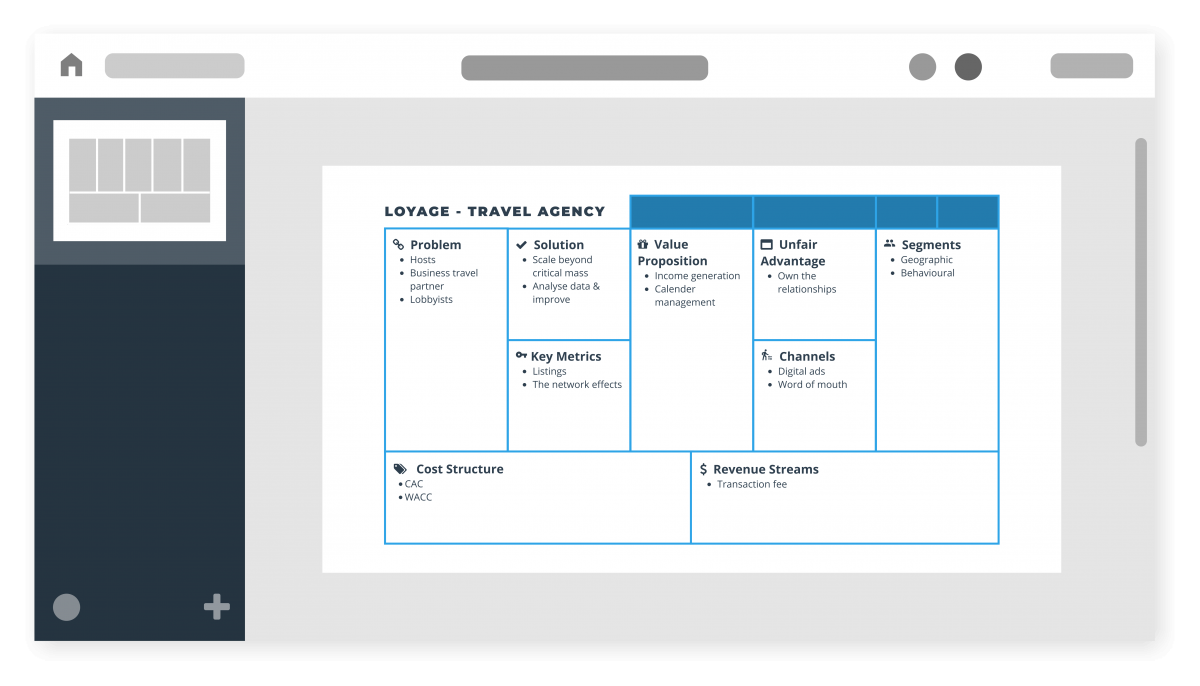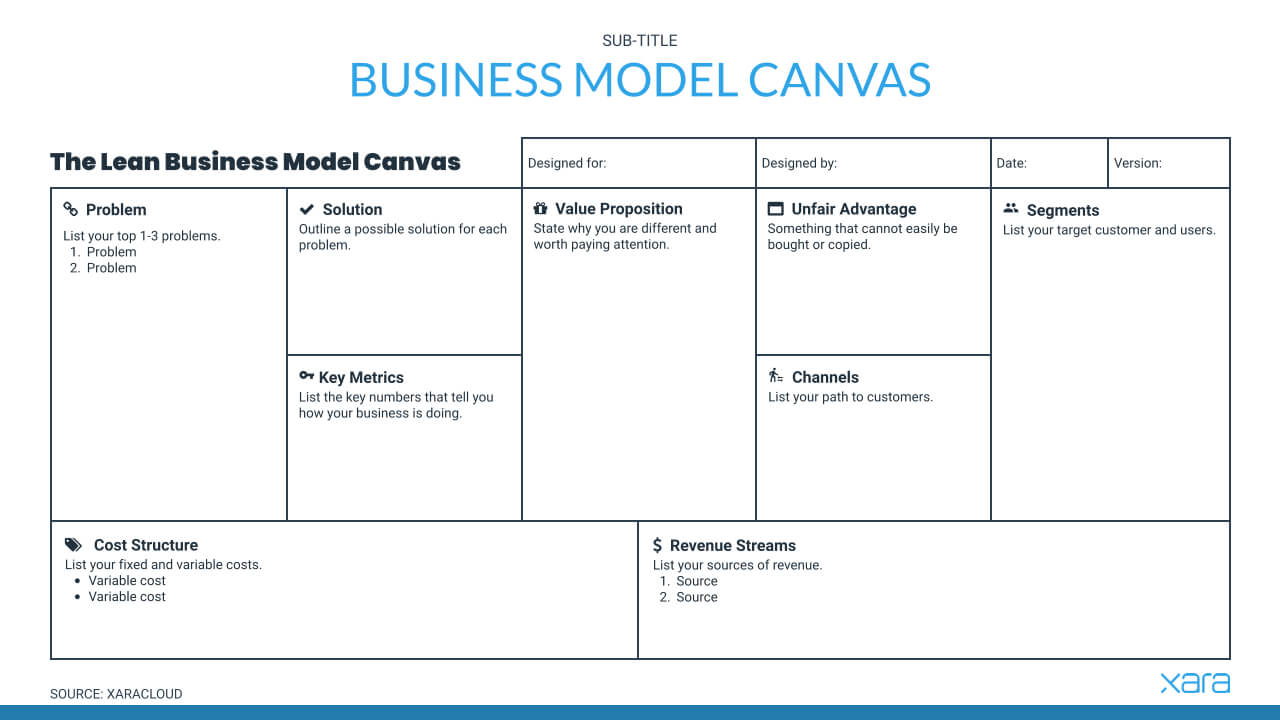Business Model Canvas
Create a tool that helps you understand the business model behind a company, simply and quickly.

If you’re starting or running a small business, it’s important to have a solid understanding of your business model. You can use a business model canvas template to help you get started. This handy tool lays out all the key components of your business in one place. It’s a great way to get clear on your strategy and make sure your business is headed in the right direction.
Ready to give it a try?
As seen on:




What Is the Purpose of a Business Model Canvas?
The business model canvas (or BMC) is a tool that can be used by entrepreneurs and business owners to map out their business strategies.
The canvas is divided into nine sections, each of which represents a different aspect of the business.
This tool focuses on:value propositions, customer segments, channels, customer relationships, revenue streams, key resources, key activities, key partnerships, and cost structure.
By filling out the canvas, business owners can get a better understanding of their business and develop a plan to achieve their goals. The business model canvas can also be used as a tool for brainstorming new ideas and testing out different business strategies.
More so, you can use the business model canvas template to study a competitor’s business model. Ultimately, the purpose of the business model canvas is to help businesses succeed by providing a framework for thinking about and planning their business.
Benefits
Simple
format
A business model canvas should be just one side of a paper.
Helps to
prioritize
With one page format, you can add only the essentials, leaving all the non-important ideas out.
Easy to
understand
No need to read endless papers, reports and other documentation.
Business Model Canvas vs Business Plan
The business model canvas and the business plan are two of the most commonly used tools in the business world. While they both give an overview of the business, they aren’t created equal.
A business plan is a long-form written document. Generally, it provides an in-depth view of the business and it includes everything from core values and mission to business strategies and competitive landscape. Usually, the business plan is created before launching a business and gets updated regularly. You can use it to secure funding and track progress. More so, it’s the perfect document to hand to someone who doesn’t know anything about your business.
A business model canvas is a visual roadmap of your business model, and it can be used for generating new business ideas. It does not take into consideration external factors such as the competitive landscape, but rather focuses on the unique value proposition. This is why it’s helpful when analyzing a company’s business model.
All in all, both are useful tools that help entrepreneurs evolve. Choosing the right tool depends on your goals.
Business model canvas templates
Before you even open a template to create your canvas, you should ideally have answers to the key questions regarding your business. If not, it’s a great moment to brainstorm with your team until you have some answers you’re satisfied with.
Benefits of a Business Model Canvas
1. Focus
With its focused approach, a business model canvas allows business owners to gain clarity into the main drivers of the business. While a business plan is mandatory to have, it also documents non-core drivers of the business. This is useful, no doubt, but it can steer the focus away from the main drivers of your business.
2. Time-effective
The business model canvas is perfect if you want to quickly refresh your memory on the business model and gain insights into new strategies that could help you achieve your business goal. The BMC takes just minutes to create and read. That’s the beauty of it.
3. Transparency
A business model canvas is a great tool for businesses to increase transparency and collaboration within their organizations. It’s compact and visual, which makes it easy for employees to access it and gain insight into the business model and strategy.
4. Common Language
The business model canvas provides a clear and concise framework for businesses to identify and articulate their business model. This common language and structure allow businesses to communicate their business model more easily to employees, partners, and shareholders.
5. Flexible and Agile
The business model canvas is focused on quality over quantity. As opposed to a traditional business plan, the goal of a business model canvas isn’t to document in minute detail every aspect of the business. Rather, the goal of the business model is to describe the key block of your business.
This makes it a flexible and agile tool since it can be adapted on the go.

How to Create a Business Model Canvas
To create a business model canvas, you need 30 minutes, a cup of coffee, willpower, and a template to make things easy.
Here is what the business model canvas template should contain:
1. Value Proposition
At the heart of the business model canvas lies the value proposition. After all, this is the core of any business. The value proposition sets the tone for all the other building blocks.
To find out your unique value proposition, brainstorm these questions:
What makes your business unique? How does your solution solve the target audience’s problem? More importantly, why should they choose you over your competitors?
These are the questions you need to answer in this section. Write them all out, and prioritize. Add only the most relevant value propositions.
2. Customer Segments
This is the section where you describe your target audience. You can’t target everyone. Even though that sounds tempting and profitable. So, the question you want to answer in this section is: Who are the customers?
To sketch this section, you need to focus on these elements:
Market Segments
Are you a single-sided business or a multi-sided business? Multi-sided businesses serve 2 or more market segments that depend on each other. For instance, Airbnb has to target property owners. Media outlets have 2 segments to serve: readers and advertisers.
If you are a single-sided business, you can still segment customers by various dimensions: such as demographics, psychographics, or geographical location.
Personas
Once you’ve pinpointed the segment dimensions, it’s time to go micro and create the personas. This is a representation of your ideal customer.
For each customer segment, you should have at least one person report. You can create your persona using information from your Google Search Console account, or host focus groups and interviews to collect more information about your customer base.
Also, make sure to create personas for buyers AND users. Let’s say you sell coffee beans. You could create a persona for those who drink the coffee and one for those who gift it.
Once you have a clear picture of who your customers might be, you should describe what their needs, pain points and motivations are.
3. Customer Relationships
Customer relationships are the bread and butter of any business. They keep the lights on and the sales flowing. And without happy customers, there would be no business at all.
That’s why it’s so important to keep track of the customer relationship process. In this section, you should describe how you interact with customers at each step of their journey.
For instance, in the consideration stage, you might want to blog about your offering. The most common channel in this respect would be your website. In the selling stage, however, the channel might differ if you sell products through third-party apps or in physical stores.
Think about each customer stage and link these to your channels.
4. Channels
Once you create your personas, you need to hash to figure out how you’re going to reach them and communicate the unique value your product or service brings to the market. You also need to establish where you will sell and service your customers.
These are your marketing and sales channels.
5. Revenue Streams
How does your business generate revenue?
This is what you should cover in this section. Some businesses have multiple revenue streams, while others stick to one. For instance, Netflix generates revenue through membership fees, while H&M generates revenue through direct sales.
If you have multiple customer segments or value propositions, you should connect each one with your revenue streams.
6. Key Resources
What assets does the company need to perform the key activities and deliver the value proposition? And for the distribution channels, customer relationships, and revenue streams?
There are multiple types of assets that businesses use in their day-to-day operations:
- Physical assets – things such as buildings, vehicles, or machinery.
- Digital assets – everything from business documents to branded content.
- Fixed cost assets – employees are a key resource in this regard.
- Intellectual resources – brands, copyrights, knowledge base, or customer databases.
- Financial assets – things such as stocks, cash, or credit.
7. Key Activities
What do you do on a day-to-day basis to deliver that value proposition to customers and generate revenue?
List all the key activities here. To prevent over-stuffing this section with activities, look at your value proposition. This will guide you through the focal activities of your business.
First and foremost, add the tasks you do to deliver the value proposition to customers. For instance, if you provide chic, yet sustainable fashion items, one task might be acquiring second-hand clothes to upcycle them. Or researching the latest trends in sustainable fashion.
Next, think of all the other main activities that keep the business going. What activities are needed for your customer relationships, distribution channels, and revenue streams? Add these to the business model canvas template as well.
8. Key Partners
You’ve added key activities to the business model canvas template.
However, some key activities are dependent on partners. Without them, the company couldn’t perform these activities on its own. Create a list of these key partners and link them to the corresponding key activity.
9. Cost Structure
By now you should have a clear picture of what the company does to deliver value to its customers and generate revenue. What are the main costs associated with each key activity?
Costs can be:
Fixed — think of insurance or rent. These don’t vary depending on volume.
Variable – think of materials or wages.
This split will determine how your costs change as you scale. Do they go up linearly or can you take advantage of economies of scale? This is an important distinction that will also have an impact on how big your market needs to be.
Uses of Business Model Canvas
Alright! The business model canvas template is all filled in.
What now?
We have gathered some of the main ways in which you can use the BMC to analyze your business model and come up with business innovations.
Obviously, the first goal of the BMC is to analyze the business model. Is the model accurate? What could be improved? What do team members think? Do they have any additional ideas?
The business model canvas template is also useful if you want to analyze the competitive landscape and find ways to maintain or gain competitive advantage.
We saved the best for last. You can use the business model canvas to think of innovations in your field and generate different business models ideas.
What insights emerged from your business model canvas? Any opportunities or obstacles? Are there any better ways to solve the customer’s pain points? Could you generate revenue differently? Does it make sense to?
These are just a few questions to get you started. To really get things going, you might want to operate in a design thinking framework. Design thinking is a framework when you want to innovate and solve problems.
Create your Business model canvas
in Xara Cloud
We offer the Business model canvas for free!
Xara Cloud allows you to share and edit documents with your colleagues or friends.. live!
Easy to create, and it’s also
print-ready – simply export it in PDF, PNG or JPEG.
